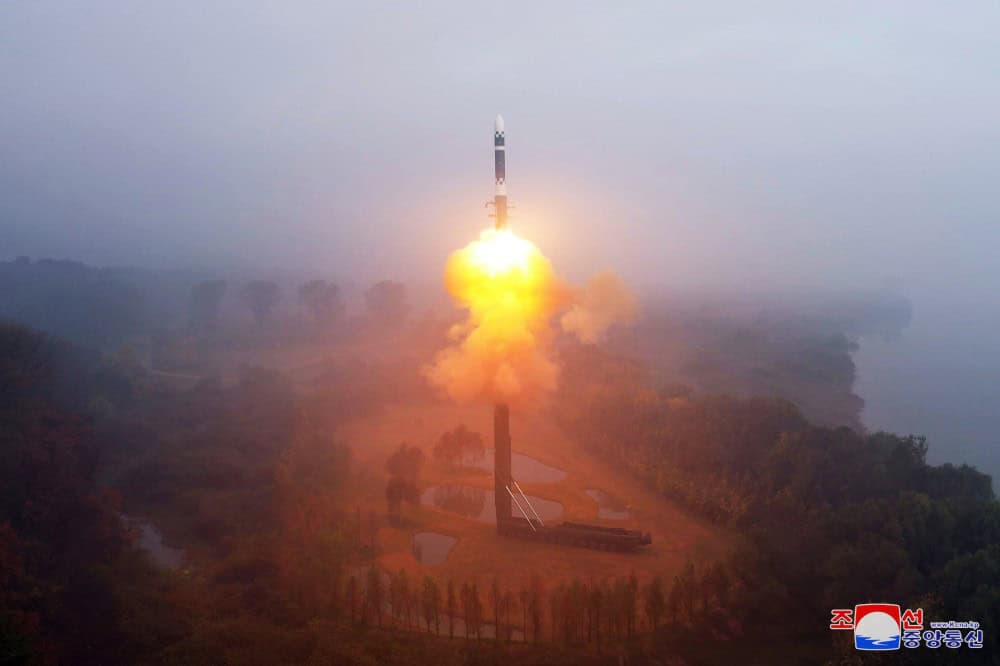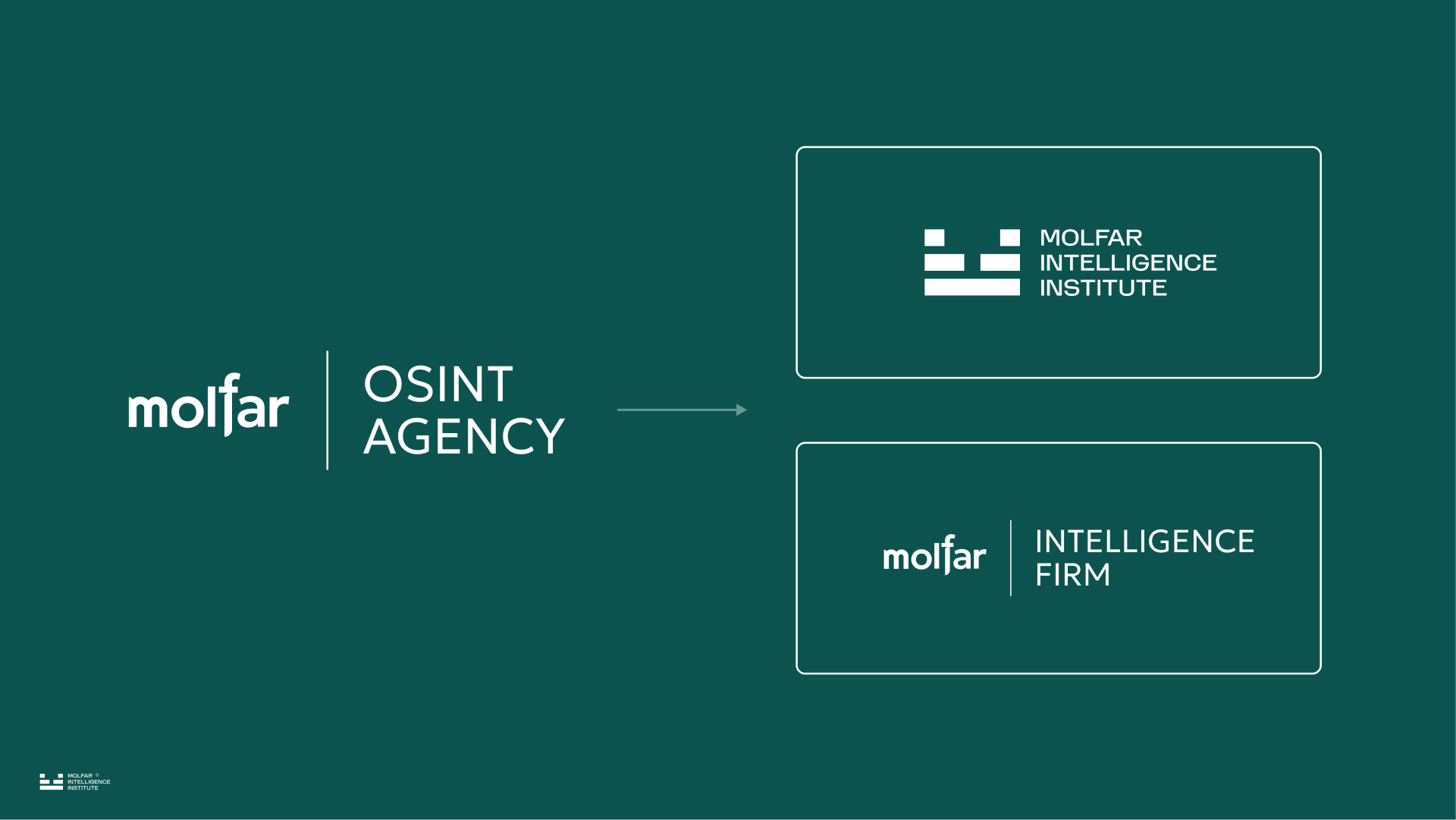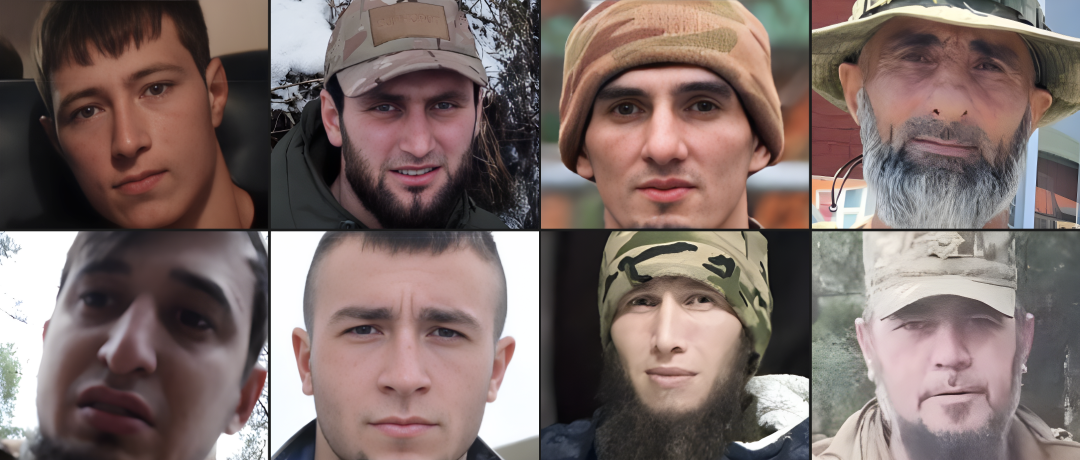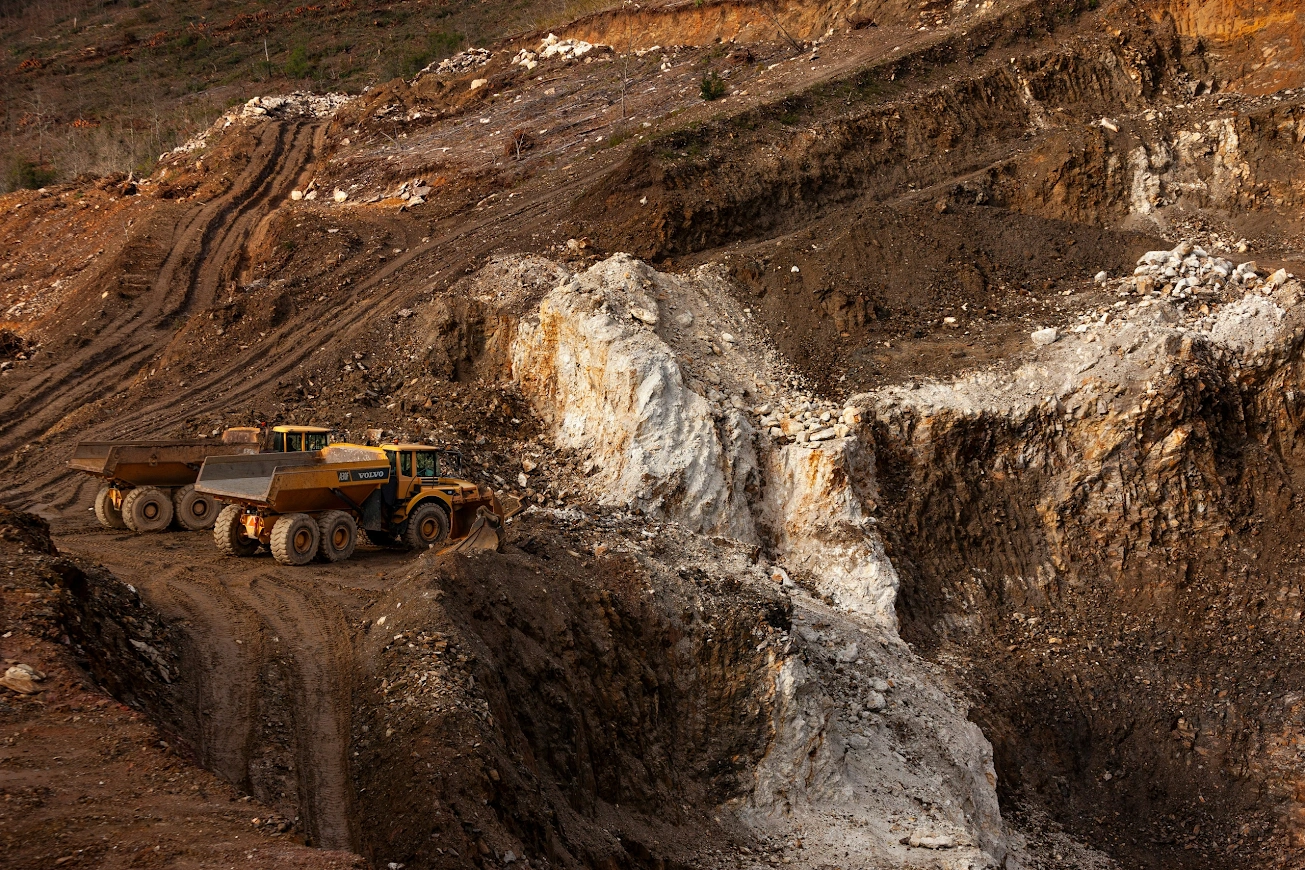02/03/2025
On December 30, 2023, Russia launched its first recorded attack using missiles acquired from North Korea. Previously, cooperation between Moscow and Pyongyang focused only on supplying artillery and ammunition. Despite sanctions, North Korea continues to produce rockets and transfer them to Russia for attacks on Ukraine.
Analysts at Molfar have investigated specific aspects of this collaboration between the two dictatorships, detailing how North Korean short-range ballistic missiles evade international restrictions, the delivery routes they follow, and the locations where they are stored before being used against Ukraine.
North Korean Missile Strikes on Ukraine
Massive Missile Attack on December 30, 2023
One of the first recorded attacks using a North Korean ballistic missile occurred on December 30, 2023. As a result of the attack, at least 24 civilians were killed, and over 100 sustained severe injuries. The Russians launched 16 North Korean-made missiles at Ukraine, targeting Kyiv, Kharkiv, the Donetsk region, and Zaporizhzhia.
This attack followed a statement from the U.S. government in early December concerning the supply of ballistic missiles. The first transfer of such missiles likely occurred in November 2023. Later, another report confirmed the delivery of artillery ammunition to Russia by sea between December 21 and 25, 2023.
On February 22, 2024, the Security Service of Ukraine (SBU) reported on Telegram that they had found confirmation of Russia's use of North Korean missiles. Specifically, the report mentions North Korean ballistic missiles Hwasong-11 (KN-23/24).
On December 20, 2024, St. Nicholas Church in Kyiv was damaged.
On the morning of December 20, 2024, Russia launched a ballistic missile attack on Kyiv. As a result, one person was killed, and ten were injured. The attack also damaged a heating pipeline and St. Nicholas Church in Kyiv. Simultaneously, Russian forces targeted infrastructure facilities in the Dnipropetrovsk, Sumy, Kyiv, and Kharkiv regions.
KN-23 Missile Strike on Kharkiv Region, September 2, 2024: Consequences and Details
On the night of September 2, 2024, Russia carried out a combined missile strike on Ukraine. Among the weapons used that day were 16 North Korean missiles, one of which struck Kharkiv. The attack resembled the strike on the capital on July 8, 2024, when a Russian missile hit the Okhmatdyt Children's Hospital. In total, air defense forces destroyed 22 missiles and 20 Shahed drones during the attack.
Between December 30, 2023, and December 25, 2024, 32 recorded incidents were identified in which Russia used North Korean-made ballistic missiles, including the KN-101, KN-102, and KN-103 types. In total, Russia launched between 101 and 103 such missiles.
This list was compiled based on open-source data from reports by the Ukrainian Air Force and the Prosecutor General's Office.
Chronology of North Korean Missile Strikes on Ukraine
Date | Quantity | Type | Location of Strike | Probable Launch Siteу | Comment |
KN-23 | Zaporizhzhia | - | - | ||
- | KN-23 | Kyiv | - | - | |
- | KN-23 | Kharkiv | - | - | |
Kharkiv | - | - | |||
KN-23 or KN-24 | Kharkiv | Belgorod region | - | ||
KN-23 | Kyiv | - | - | ||
KN-23 | Kharkiv | Belgorod region | - | ||
KN-23 | Pavlohrad | - | - | ||
KN-23 | Selidove, Donetsk region | - | - | ||
KN-23 | Kyiv | Voronezh region | 1 intercepted | ||
- | KN-23 | - | Voronezh region | During the night of the 26th to the 27th | |
2 | KN-23 /Kh-47М2 "Kinzhal" | Kyiv region | - | 2 intercepted | |
1 | KN-23/24 | Kyiv region | - | - | |
4 | KN-23 | Kyiv region | Voronezh region | 2 intercepted | |
4 | KN-23/24 | Kyiv | Voronezh region | - | |
2 | KN-23/24 | Moskalienky, Kharkiv region | Voronezh region | Not intercepted | |
2 | KN-23 | - | Voronezh and Kursk regions | 2 intercepted | |
2 | KN-23 | - | Voronezh region | Not intercepted | |
2 | KN-23 | - | Voronezh region | Not intercepted | |
2 | KN-23 | - | Voronezh region | Not intercepted | |
6 | KN-23 | - | Kursk, Voronezh regions, Crimea | 1 intercepted | |
KN-23/24 | Kharkiv | Bryansk, Voronezh, and Kursk regions | 9 missiles were intercepted | ||
KN-23 | - | Crimea | Not intercepted | ||
5 | KN-23 | Pavlohrad, Dnipropetrovsk region | Voronezh, Rostov regions | Not intercepted | |
4 | KN-23 | Dnipropetrovsk region | Crimea, Rostov region | Not intercepted | |
1 | KN-23 | - | Crimea | Not intercepted | |
KN-23 | Poltava region | Kursk region | Not intercepted | ||
1 | KN-23 | - | Crimea | Not intercepted | |
3 | KN-23 | - | Crimea | Not intercepted | |
1 | KN-23 | - | Crimea | Not intercepted | |
4 | KN-23 | Zatoka, Odesa region / Kramatorsk | Crimea, Rostov region | Not intercepted | |
2 | KN-23 | - | Voronezh region | Not intercepted | |
1 | KN-23 | - | Bryansk region | Not intercepted | |
5 | KN-23 | Kyiv | Bryansk, Voronezh regions | Intercepted | |
2 | KN-23 | - | Voronezh region | - | |
101 - 103 |
Russian Military Ranges Under Sanctions: What Is Known About North Korean Missile Testing
By sea, air, and rail — North Korea delivers weapons to Russia by all possible means. In early 2024, the U.S. imposed sanctions on several Russian entities involved in the transportation and testing of firearms. Specifically, the sanctions affected:
- 224th Flight Squadron — a state-owned cargo transport company under the Russian Ministry of Defense. In 2022, sanctions were imposed on 41 aircraft from this company. In November and December 2023, planes from this company (RF-86898, RF-78757, RF-82011, and RF-82041) were involved in transporting ballistic missiles. Sanctions were also imposed on its director, Vladimir Mikheychik. The base of operations is likely the Chkalovsky airfield, Moscow region.
- The Flight Testing Center in Vladimirovka, Astrakhan, is involved in testing ballistic missiles, likely developed by North Korea. Its location has been confirmed through satellite imagery.
- Ashuluk Combat Range, Astrakhan ("185th Combat Application and Combat Training Center of the VKS") — a site used for missile testing and training the Russian Aerospace Forces. The range also has an airfield, which supports the transportation of equipment and weapons.
Weapon Supply Routes from North Korea to Russia: Ports, Ships, Railways
Sea Freight Shipments from the North Korean Port of Rajin to Russian Ports in the Primorsky Krai.
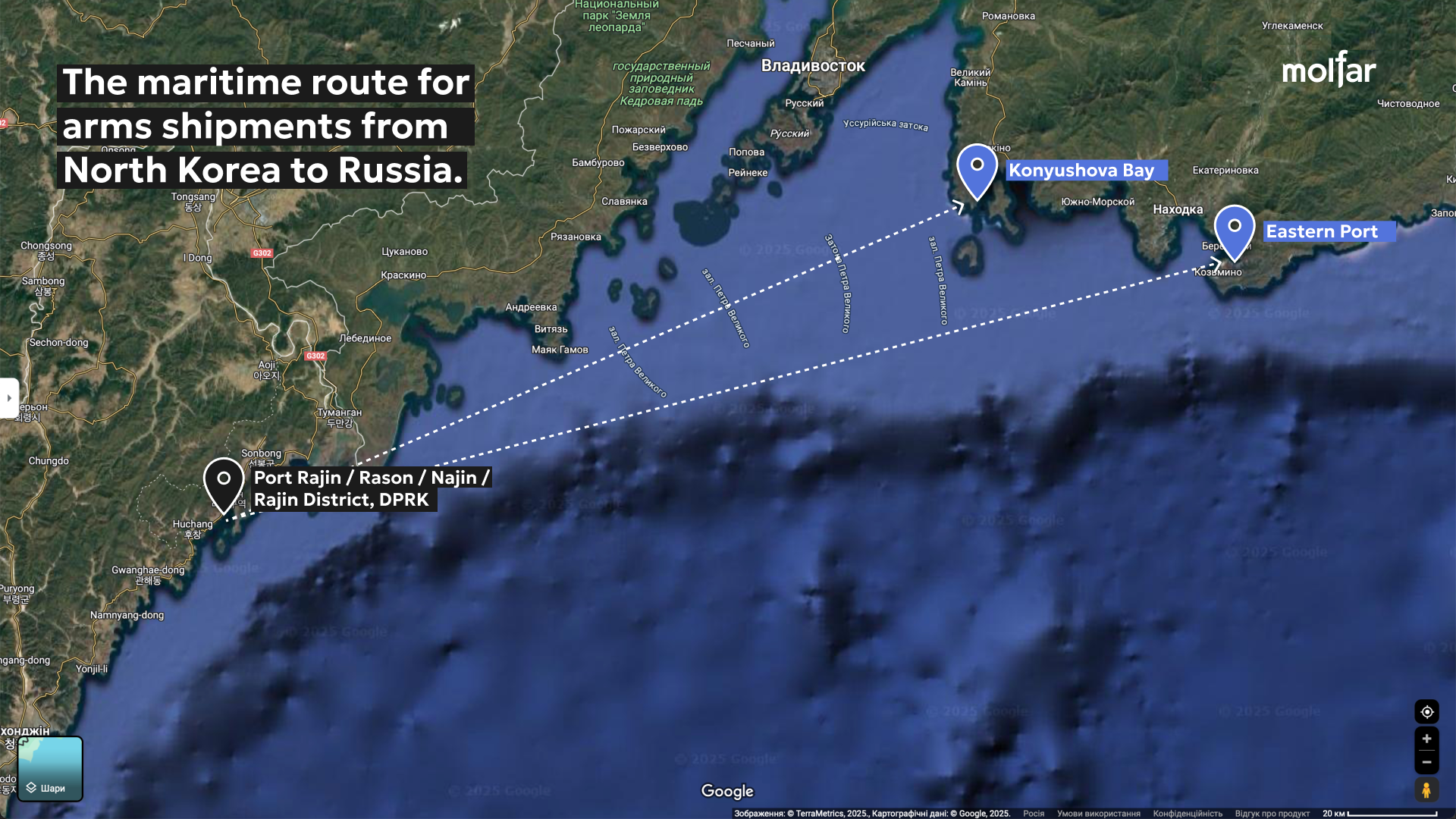
Maritime shipments of weapons from North Korea to Russia are conducted from the Rajin / Rason / Najin / 라진구역 port in North Korea. Russia receives these deliveries at two ports:
1. Konushkov Bay is a small port area near Vladivostok. It is located near a railway and the military factory DVC "DalRAO," which specializes in the disposal of radioactive waste and has a laboratory for nuclear energy research.
Cargo ships Angara (IMO 9179842) and Maria (IMO 8517839) have been recorded traveling without transmitters (signals) between ports from mid-August until October 14, 2023. During this period, artillery munitions were transported, with the final destination being an arsenal in Tikhoretsk, Krasnodar Krai. According to statements from South Korea, ballistic missiles from North Korea have also been delivered by this route since November 2023.
According to an investigation by the analytical platform Beyond Parallel, no vessel activity was detected during unloading at the Danube port from late December 2023 to early February 2024.
2. The Eastern Port is the largest in the Russian Far East, 40 kilometers from Vladivostok. It specializes in the export of coal, oil products. It handles over 55 million tons of cargo annually.
The terminal for receiving civilian cargo is located in Vrangelya Bay. From October 2023 to February 2024, 19 ships without signals were recorded entering the port. British intelligence noted the ship MAIA 1 (IMO 9358010) in the port on February 22, 2024, with its signal turned off and cargo loaded from Rajin. Three more ships without signals have not been verified.
Four vessels have been identified as involved in transporting munitions from North Korea to Russia. According to a publication by "Slovo i Dilo" Ukrainian media, these ships carried artillery munitions from North Korea to Russia. Ballistic missiles are likely transported in the same manner.
Ship Name | IMO | Ports | Date(s) |
9358010 | |||
9161003 | At sea, near Vladivostok port | ||
9179842 | Zhoushan Xinya Shipyard (Chinese repair port) | Since 09.02.2024 | |
8517839 | At sea, near Vladivostok port |
*Last known location as of March 4, 2024
These ships have been subject to U.S. sanctions since 2022 for transporting military equipment for the Wagner Group.
After arriving at the ports, the ammunition is likely transported by rail to warehouses and training grounds.
Rail transport between North Korea and Russia is also used to move ammunition. Satellite images of the Tumangan hub from October 2023 to January 2024 showed intense movement of freight cars across the border. Instances of artillery ammunition transportation were also previously recorded, particularly in November 2022.
Where in Russia are North Korean missiles stored?
Several storage locations in Russia hold ammunition and missiles brought from North Korea. One such facility is the Tikhoretsk depot in the Krasnodar region.
"Tikhoretsk" is among Russia's three largest bases for ammunition storage and an important logistical hub. On September 18, 2024, the Ukrainian Armed Forces struck this depot just as another shipment of South Korean missiles arrived. After the strike, ammunition detonations began at the site.
In North Ossetia, near Mozdok, another important depot is located. The city hosts an airbase that has been used for missile strikes on Ukrainian territory since 2023.
Another storage location is the Yegorlik airfield in the Rostov region, 3 km from the Yegorlikskaya stanitsa and 35 km from Zernograd.
Russia uses specialized missile testing ranges. For example, the flight testing center in Vladimirovka, near Astrakhan, tests ballistic missiles, including those that may be related to North Korea (1, 2). Another testing location is the Ashuluk range (Google Maps). The 185th Combat Application and Combat Assignment Center of the Aerospace Forces provides missile testing and military pilot training.
As we can see, Russia and North Korea have established a strong partnership and infrastructure that allows for the storage, production, and large-scale testing of missiles.
What missiles has Russia received from North Korea?
_1738682892.png)
North Korea has built a massive missile arsenal despite international sanctions. Most of these missiles are modifications of Soviet or Chinese designs; for example, the "Scud" is a modified version of the "Iskander-M" or "Smerch." One of North Korea's key manufacturing facilities is likely the "February 11" factory, though the country also has other enterprises.
For example, the missile known as "KN-23 / 9K720 Iskander-M / Hwasong-11A / 11Ga" modified the Russian Iskander-M, developed in 1999 and first adopted into service in 2006. It has been in service in North Korea since 2018, with tests conducted in 2019.
Among the manufacturers are "Siemens," "Fairchild Semiconductor International, Inc.," "Analog Devices, Inc.," "NSK Ltd. / NSK Automation," "Zhongkewei," "NXP Semiconductors," and "XP Power." Since 2006, North Korea has been under U.S. sanctions on electronics supply.
According to Joseph S. Bermudez Jr.'s article and the study of The Hague Code of Conduct, which ensures transparency, monitoring, and the prevention of missile technology proliferation, solid-fuel engines for the KN-23 and KN-24 missiles are likely produced at the Explosives Factory No. 17 in South Hamgyong Province and at the "February 11" factory, according to the CAR agency.
According to the Korea Institute for Defense Analysis assessment, each missile modification of Hwasong-11s (nuclear carrier) costs $5 million. During the test period, North Korea fired 120 missiles of the KN-23 or KN-24 type.
The chronology of cooperation between North Korea and Russia
As of February 3, 2025, The New York Times reports that North Korean troops have been withdrawn from the front line in the Kursk region. The withdrawal was likely due to significant losses suffered by North Korea. According to the Commander-in-Chief of the Armed Forces of Ukraine, Oleksandr Syrskyi, their numbers have been reduced by half over the past three months.
On February 4, 2024, the head of the Main Directorate of Intelligence of Ukraine, Kyrylo Budanov, refuted media claims about the withdrawal of North Korean troops. According to him, about 8,000 North Korean military personnel are still engaged in combat on the front lines against Ukraine. Their activity has recently decreased. Budanov emphasized that reports of a complete withdrawal of these forces are incorrect. He explained that losses among North Korean units are significant, but their presence on the battlefield remains.
As of January 28, 2025, it is known that 12,000 North Korean soldiers are present on Russian territory, particularly in the Kursk region. As of mid-January 2025, the losses of North Korean soldiers amount to about 4,000, with approximately 1,000 killed, while the rest have been wounded, gone missing, or taken prisoner. On January 28, 2025, the Ukrainian Armed Forces reported the capture of two North Korean soldiers in the Kursk region. Despite this, cooperation between Russia and North Korea intensified after the strengthening of international sanctions in 2022. The interaction between the two pariah states is based on resource exchange, weaponry, and diplomatic support. Russia and North Korea quickly became "brotherly" nations.
On February 27, South Korean Defense Minister Shin Won-sik stated in an interview that North Korean ammunition factories operate at full capacity in exchange for food and raw materials from Russia.
The supply of artillery, ballistics, and other types of weaponry from North Korea to Russia is just one aspect of their cooperation. After the start of the full-scale invasion, Russia first made contact with North Korea through its puppets, the so-called "L/DNR". In May 2022, a meeting took place in Moscow between the "foreign ministers" of the "L/DNR", Natalia Nikonorova and Vladislav Deinego, and the North Korean ambassador to Russia, Sin Hong Chol. Two months later, North Korea announced its recognition of the "DPR". The fact that Russia was purchasing weapons from North Korea became known on September 6 of the same year.
At the beginning of 2023, there were the first reports that North Korea was planning to send 300-500 people to the Russian-occupied territories of Ukraine. Weapon supplies became particularly active following the visit of former Russian Defense Minister Shoigu to North Korea. From April 1, 2022, to November 29, 2024, there were 161 supplies instances and 47 meetings at various levels. According to open data, Molfar analysts analyzed that Russia supplied oil to North Korea 19 times during this period.
The rows of this chart represent various aspects of interaction between Russia and North Korea. For example, the "Documents" row records signed agreements, including the strategic partnership treaty between Russia and North Korea on June 19, 2024. A separate row highlights the transfer of oil from Russia to North Korea, which is a significant element of their economic cooperation. One example of gift exchanges was when Vladimir Putin presented Kim Jong-un with a train filled with valuable gifts. At the same time, railway connections between the two countries were restored via the Friendship Bridge.
The use of ballistic missiles KN-23 and KN-24 despite international sanctions demonstrates the strength of the military cooperation between Russia and North Korea. They have established well-organized logistics, using maritime routes and railways, and test missiles at Russian testing ranges. North Korea has also sent its military personnel to Russia. These two dictatorial countries will continue to strengthen their cooperation. From December 30, 2023, to February 22, 2024, Russia launched a minimum of 20–24 North Korean ballistic missiles. The Ukrainian Prosecutor General's Office stated that they examined the remnants of 21 out of approximately 50 North Korean ballistic missiles used against Ukraine. From October to November 2024, another 100 short-range ballistic missiles of the KN-23/24 type were supplied. From December 2023 to December 31, 2024, 101 North Korean-made missiles against Ukraine were officially confirmed.ʼ

